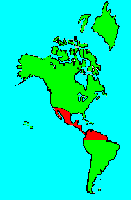SPECIES INFO
Red-capped manakin (Pipra mentalis) is found from southern Mexico south to eastern Panama and further south to western Ecuador. This 4 inch male manakin has a red head contrasted with a solid black body. The female is greenish yellow with a greenish yellow head and upper body. The middle and lower breast is quite pale.
There are three subspecies. The nominate subspecies , Pipra mentalis mentalis, is found from south eastern Mexico south to eastern Costa Rica. The subspecies ignifera is found from western Costa Rica south into western Panama. The subspecies minor is found from eastern Panama south to western Ecuador.
Garrigues notes this is common in wet lowland forests in Costa Rica.The Pipridae family (or subfamily Piprinae) can be placed in a variety of taxonomic places. We have tentatively placed this is the larger Pittidae super family. There are about 48-53 species in this Pipridae family that is confined to the New World tropics. These are generally about 4 inch very colorful birds found in woodlands. (Several species have long tails giving them greater length.)
Although there is no agreement among bird taxonomists as to the placement of the Pittidae (Pittas)(30 species, 32 in Clements in 2007) and the Pipridae (Manakins) (48 species, recently to 58 species per Clements in 2007), we have tentatively placed these two families near each other in the larger Pittidae super family.
Clements in 2007 in his world check list counted 32 species in the Pitta family. Furthermore, he placed all the species in this family into a common genus entitled "Pitta". However, in some more recent field guides, we note that this genus has been divided to include the genera Hydrornis, Erythropitta, and Pitta.
In most modern bird taxonomies, the perching birds (Passeriformes) is treated as a single order. This large order has about 5739 different species. A common characteristic of this order is three forward toes and one reverse pointing toe. Most of species are also characterized by a tendon locking mechanism that permits their feet to lock onto branches when they relax. Recently, Monroe and Sibley in 1993 have divided this large order into six main divisions. To help our users navigate this gigantic number of species, we have arbitrarily placed these 6 different divisions at the order level.
This division can properly be referred to as:
Order Passseriformes (5739 species)
Suborder Tyranni (1159 species)
Infraorder Eurylaimides (49 species)Broadbills, Pipits, and relatives (Suborder Eurylaimides) can be divided into several different groups: The broadbills (Eurylaimidae), the pipits (Pittidae), and the Asities (Philepittidae). Most authors give each of these groups family status. Others place them in a suborder Tyrannides. Herein, we place these three groups into an suborder entitled Eurylaimides.
Aves contains about 8,650 different species of living birds known to science. Each year about one new species is discovered in some remote rain forest or remote island. In addition, scientists have been raising many subspecies to full species status which may raise the species count to 10,000. Birdlife recognizes 10,027 species as of 2011.
However, each year about one species goes extinct. The rate of extinction is increasing, and the rate of new discovery is decreasing, so that the number of bird species will soon begin to decline rapidly. Although different taxonomists would organize the birds differently, there are approximately twenty-seven orders of birds. These orders are broken down into about one hundred and fifty-five different families.
Recent research of the genetic structure of some of the shore birds and owls would indicate that the present organization of orders and families should have some modification.
The birds are a worldwide group of animals that are characterized by having the front limbs modified into wings that are used for flying. Perhaps the most unique feature of the birds is the feathers. These feathers are made up of a central support called a quill and a series of small filaments that are hooked together as barbs.
For many years it was believed that Archaeopteryx discovered in Bavaria was the oldest bird from about 150 million years ago. However, in l986, Sankar Chattterjee, a Texas paleontologist, reportedly discovered a bird in the genus Protoavis that lived about 225 million years ago.
When this project was begun in 1978, we used Austin & Singer for bird taxonomy. Since then, we have adopted many changes, but have kept some older concepts that are still found widely in the literature. Recently, we have used Clements and Howard & Moore. Very recently, we have used Monroe and Sibley for the higher taxonomy of the perching birds.
Backboned Animals (Phylum Chordata) are the most advanced group of animals on earth. These animals are characterized by having a spinal cord or backbone. Most members have a clearly defined brain that controls the organism through a spinal cord. Fish, amphibians, reptiles, birds, and mammals are in this phylum.
Currently, some taxonomists believe that the fish should be divided into two groups (sharks and regular fishes) and that there are some other primitive groups in the phylum such as hagfish or lampreys.
Animal Kingdom contains numerous organisms that feed on other animals or plants. Included in the animal kingdom are the lower marine invertebrates such as sponges and corals, the jointed legged animals such as insects and spiders, and the backboned animals such as fish, amphibians, reptiles, birds, and mammals.

